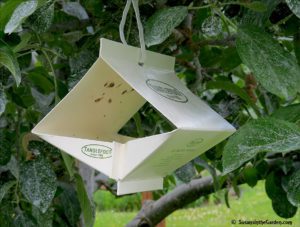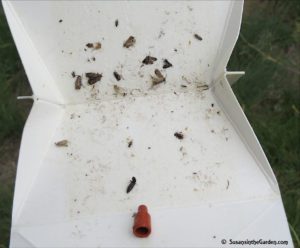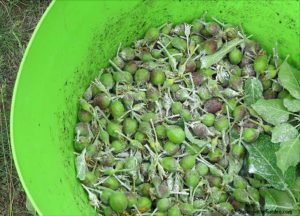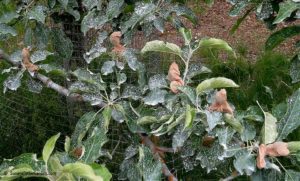Growing apples organically, part 2

I recently wrote a post on Growing apples organically, but wanted to do a follow-up today. I get a lot of questions from readers about how to do this, so this post should help.
Last week, we decided it was high time we thinned and covered our young apples. The covers help protect them from the apple codling moth, which lay eggs on apples. In my previous post, I gave a general overview of how we accomplish this. But I thought you’d like to see some specifics.
Organic orchard care:
I mentioned how Bill put a sticky trap in our little orchard a few weeks ago. We use it to detect when the moths are active in our area. Here’s what one looks like in the photo to the left. The photo below shows a photo of moths stuck on the inside to the sticky TangleTrap coating. What’s the red thing in the foreground of the photo below? It contains female codling moth pheromones (sex hormones) to attract the male moths. Remember that you can click on any photo to view an image in more detail.
Once Bill saw there were moths in the trap, he knew it was time to act. We typically wait until our apples are the size of large marbles to thin and cover them. Bill had already sprayed the apples and leaves with a mixture of kaolin clay and water the day before. You can learn more about that in my previous post.
I find it difficult to thin apples because I hate to remove all those potentially yummy apples!
There are three very important reasons to thin the apples on your tree:
Trees only have enough energy to grow a certain amount of apples. If you don’t thin them each year, your tree will become an “alternate bearer.” This means you’ll get a crop every other year, rather than each year.
- The branches will become too heavy from the weight of all of the fruit. They’ll need to be supported or you’ll risk having some branches break.
- Are you’re going to cover your developing apples with nylon footies? (refer to previous post for information and sources) The fewer you have to cover, the better! I should clarify that the official name for the footies is “apple maggot barriers.” In Spokane County, we don’t have apple maggot flies. But these barriers work well to keep the codling moths from laying their eggs on the apples.
This is just a sample of the thinned apples in my bucket during the process. Our goal is to thin a cluster of young apples to the strongest apple. And preferably one that is pointing upward so the nylon footie won’t slip off later. We tend to thin the apples to where there’s only one apple every 8 to 12 inches. I know that sounds drastic, but it’s really the best practice.
Cover apples with the nylon footies:
Once the thinning is done, we cover each remaining apple with a nylon footie. To do that, we gently open up one end of the footie and slip it over the apple. We put it as close to the sewn end of the footie as possible. Then we give the rest of the footie a bit of a twist around the apple’s stem. That will hold them onto the apple and somewhat “seal” the footie over the apple.
This photo shows what a branch full of covered apples looks like.
Growing apples organically also includes organic sprays:
Once that that tedious task was done, Bill sprayed the apple trees again with the kaolin clay mixture. From this point on — other than monitoring the apples’ growth from time to time — we’re just watching the weather reports. Any time we have a heavy rain, Bill applies another dose of kaolin spray.
I know all of this sounds labor-intensive, but really it’s just the thinning and footie-ing that takes some time. Even so, it only took us about 4 hours to accomplish this on four heavily-bearing trees. And then it’s done for another year!
Do you have questions about growing apples organically? Don’t hesitate to drop me a note at Susan@SusansintheGarden.com.
I have more videos about orchard care and all sorts of garden topics on my YouTube channel.




